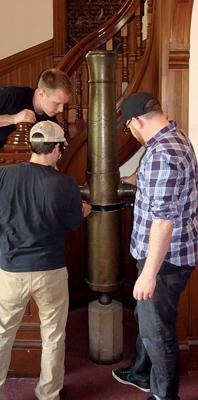By William Sweet
 Frazar Stearns (right) is the main reason that the Amherst cannon did not fall into obscurity after the Civil War.
|
Nestled in a stairwell, with its bronze bore aimed heavenward, a brass Civil War cannon has long been part of the background in Morgan Hall. “It looked like a piece of plumbing,” laments Margaret R. Dakin, archives and special collections specialist at Amherst.
Amherst students, who these days are more likely to be embroiled in debates over literary canon than battles involving artillery cannon, may not have even noticed that the “six-pounder” gun is gone. However, in one of those twists that can occur in history, a group representing the Confederacy is bringing the gun—and Amherst’s role in a Union victory—back to light.
The cannon, which fired its last six-pound shot on behalf of the Confederacy 150 years ago, has returned to former Confederate land, where it is on loan to the North Carolina Museum of History in Raleigh. While it’s had a long rest at Amherst, the 65-inch-long, 885-pound gun did a fair amount of traveling in its youth, switching sides twice during the Civil War. Manufactured at the Ames Armory in Chicopee, Mass., in 1841, it was originally a weapon for the Union. Confederates confiscated the cannon from Fort Macon, N.C., at the start of the war, and it was the first armament reclaimed by Union forces at the Battle of New Bern, N.C., on March 14, 1862.
 In Morgan Hall, preparing the
cannon for its trip to North Carolina |
New Bern was the battle that brought the war home to Amherst. In its opening skirmish, the 21st Regiment Massachusetts Volunteer Infantry lost 19 soldiers, including 21-year-old Frazar Stearns, a member of the Class of 1863 and son of Amherst’s fourth president. (Stearns was serving as adjutant to his Amherst chemistry professor, Col. William Smith Clark, Class of 1848.) Back in Massachusetts, the surviving members of the regiment presented the cannon to Amherst trustees. It bears a plaque inscribed with the names of the men lost in the battle.
Last summer, a crew removed the cannon from Morgan Hall for packing and delivery to North Carolina, after discussions with The Charlotte Artillery, Reactivated, a North-Carolina-based group of Civil War reenactors, and the Raleigh museum. It took a couple of years to work out the conditions for the loan, Dakin says, but not because of old hostilities: The cannon “needed to be handled properly. You couldn’t just hire somebody to put it in the back of their van.”
Reenactor Ted Stables, who has taken to calling the artifact “the Amherst cannon,” says it’s unusual “to be able to take one particular artillery piece and know it was in a particular battle at a particular point. So many [similar cannons] just fell into obscurity after the war. A lot of them were melted down in World War II.”
Frazar Stearns is the main reason that the trail of the Amherst cannon can be traced so well. His death was mourned throughout town and in the Northern press; Emily Dickinson wrote that her brother, Stearns’ close friend, was deeply troubled by the loss.
The cannon will remain in Raleigh until 2015, the sesquicentennial of the war’s end. Then it will come back to Amherst. They promise.
Photos from Amherst College Archives and Special Collections